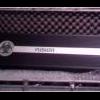-
Posts
2279 -
Joined
-
Last visited
Content Type
Profiles
Forums
Events
Media Demo
Store
Collections
Videos
Posts posted by STEvil
-
-
520+520 = 1040.
1050-1040 = 10.
There is 10 watts of rated difference.
Impedence curve is the only other thing thats going to influence whether bridged or separate will be different, but it wont mean much.
-
7970's crush 670's and 680's for rendering performance last I heard? But here I am running 670's as well, so...

-
keep the gains and subsonic in check, thats about all there is to it.
-
2ch 2ohm 520w is near identical to 4ohm bridged 1050.
Either way you can push the gain too far.
-
Better start building it, i'm a few steps past you already

edit - The bottom mounted spider is already patented.. wish more companies would pick up the tech since a single spider location is horrible for linearity..
-
Called a bass tunnel.
there is no real "tuning" for them beyond getting the enclosure to the size you want (either for SPL or SQL), but you can do things to make the tunnel act differently allowing for different rolloffs..
-
sub next to internal port mouth = loading issue.
-
from what I understand the SXX's are just SX's with a slightly larger motor, bit better ventilation, and flat wound coils..
12 cubes is small but i'd do it

-
copy the [ img ] (forum) code then paste here.
-
just because something isnt 100% built to be perfect at one thing doesnt mean it cant work great at that thing, even better than some that are built for that.
but you know everything so whatever.
-
You cant weld magnets.
wrap and fiberglass it, or wrap and epoxy coat if you want it more permanent.
-
Internal sheet braces would help. basically some flat iron on edge welded to the sheet in X pattern... along with threaded rod. It can be done in other words, but you wont have any weight savings over mdf/plywood and the bracing is going to hurt internal airflow against the sides of the box.
I think you'd have better luck making a carbon fiber box.
-
I'm hoping "box rise" should put me around 1 ohm...
Never rely on box rise for daily.
-
spray wd40 anywhere you dont want it to stick, or something oily.. maybe some pam.
-
same motor as the HK18's I think.. they took 5K RMS like champs.. for burps..

10K clipped was not healthy though lol.
edit - recone from fi or whoever will fit them as well I believe.
-
using a larger amp will not remove voltage drops. If anything it can make them worse.
that said more is better if done right.
-
They wall fine, just not as well as others is all. Plus 1500 is a bit much for L7's.
-
depends what you have for power. They love big boxes and eat up power.
You might want to add a spider hold-down as they can reach maximum excursion levels and lift a spider ring.. at least my HK18's managed to lol

-
just build a fairly large ported box.. all of the specs are pretty much junk.
What did you pay for that 15 and does it have the same motor as the HK18x1's? I'm trying to find a 4th motor to match my other 3 18's that I already have.
-
You have a loose understanding of box rise. Rise SHOULD NEVER be used as a saving factor for wiring below recommended impedances, and there is a reason why. Hell, many daily drivers are not always underrated nor should they be required to be. Rise saves setups across the entire world, and the fact is, it will change and vary depending on frequency. Hell, you don't even know what rise is as it is install/vehicle/enclosure/equipment dependent and varies from install to install. Some may experience 1.5x rise at a certain frequency, others 3x, and others 9x. But what happens when the amp actually sees .5 ohm? .35ohm? You think because at ONE NOTE it jumps from .5ohm to 2 ohm that it's saved? Music is different than burping at a tone period.
yes i am aware that the rise is different among the different frequencies just not too sure so thanks for imput. i guess i can't give you exact numbers. for my instal it works and it was a huge difference going from 1 ohm nominal to .5 ohm nominal with no observed bad effects on amp or sound quality. amp still runs cool. i guess my post is just touching the surface.
let alone when impedance drops below nominal.
how would impedence drop below sepeakers nominal load? if lets say speakers are wired at 1 ohm. how would the amp ever see less than this? never heard of that? anyone else know a thing or 2 about impedence drop?
Impedence can be influenced by either excursion or playing below tuning frequency (thus causing more excursion).
-
But now this thread can come up in a google search for the next guy that's wondering.
Along with the previous 168 threads.
-
let alone when impedance drops below nominal.
-
read post number 6.
-
Black Label Society - Fear
starts around the 15 or 30 second mark iirc.. been a while since I gave it a listen.



Just a quick and simple build for a friend of mine ..... (3930k, SLi 670's, etc.. )
in Computer Talk - News, technology, advice
Posted
Oh, just to let you know, many games and programs actually perform better with HT disabled. Test test test test!